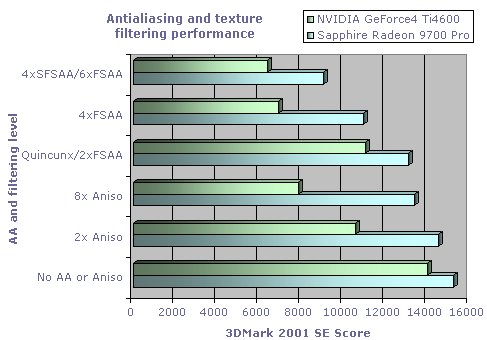Anti Aliasing and Texture Filtering Performance
On GeForce4 Ti, anti aliasing is done using multisampling. The card checks polygon edges to see if the pixels are covered by other polygons. By only testing polygon edges it only does edge aliasing in effect, something Matrox have trumpeted with the Parhelia and its 16 sample edge aliasing for polygons.
GeForce4 Ti has a couple of interesting modes that we'll test out. Quincunx which is 'soft' 4x FSAA. It's a multisample mode that does 4 pixel samples but with a less harsh result than full 4x FSAA and performance equivalent to 2x FSAA as a result.
4xS is supposedly a 2x multisample mode with 4x supersampling. Supersampling is a pixel fillrate killer (something Radeon 9700 Pro has a large advantage in already) since it means sampling each frame at a multiple size of the target resolution (in this case 4x larger) and then reducing down to the target resolution. So 4xS is a real performance killer with 2x edge AA and 4 times super sampling. We'll look at that in our tests too.
Radeon 9700 Pro does multisampling like GeForce4 Ti in 2x, 4x and 6x modes so effectively edge aliasing in those modes which is very efficient. According to Tech Report, the sample mask is static for all samples (unlike a choice of sample masks, the method of deciding if the edge should be aliased, on Radeon 8500). We'll test 2x, 4x and 6x modes.
As far as texture filtering goes, anisotropic filtering is the weapon of choice for both GPU's. It alters texture detail and applies either a bilinear filter (Radeon 9700 Pro) or fixed trilinear (GeForce4 Ti4600) depending on the position of the textured surface in relation to you the viewer.
Since it requires another texture pass and since Ti4600 can only do an expensive trilinear filter on the textures, Radeon 9700 Pro will be a lot faster than the traditionally slow Ti4600 when doing aniso. Twice the pixel pipelines helps here.
With all that in memory (hopefully!), here's the graph.

In this graph, where there's a choice of AA method in the legends, the first choice is the Ti4600 method, the second the Radeon 9700 Pro.
First off, matching up to the order of things in the graph from the hardest AA mode at the top to the 2x aniso result at the bottom, here's the percentage of performance that you lose with each setting.
Radeon 9700 Pro Performance Difference
• 6x multisample aliasing - 1.68x
• 4x multisample aliasing - 1.39x
• 2x multisample aliasing - 1.16x
• 8x anisotropic filtering - 1.14x
• 2x anisotropic filtering - 1.05x
The interesting thing here, in 3DMark 2001 SE at least is the 'free' 8x aniso filtering you get. While not technically free, when compared to the performance the Ti4600 loses with the same setting, its as free as you are going to get on a current GPU architecture. 2x aniso is really free, 5% difference is very nice. Despite the Radeon 9700's multisampling being effectively super efficient edge sampling, you still take a fair performance hit with any mode enabled with stock being a whopping ~68% faster when compared to 6x multisampling.
A combination of 4x multisampling aliasing and 8x aniso should leave anything still playable on the Radeon 9700 Pro and image quality will be excellent. Play around with the settings to see what looks nice for you. Personally, 2x AA and 8x aniso is my favourite since I prefer only a little AA in my games but maximum texture quality.
For comparison, GeForce4 Ti loses over half its performance with the unique 4xS mode but the lovely Quincunx mode is only a 23% performance hit. On Ti4600, aniso takes a larger hit percentage wise than AA whereas on Radeon 9700 Pro aniso can effectively seem free.









